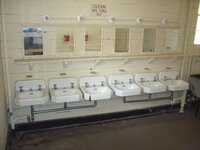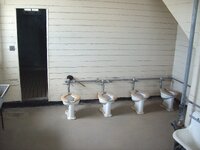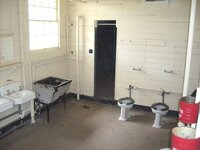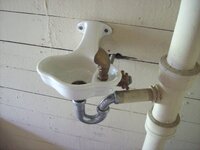In another thread, we were discussing lavatory fixtures, in part. Which reminded me of a trip I took to the mid-west in 2008. Before I was sent to Vietnam, I spent some time on a few US Army posts in the States. I've read that junior enlisted quarters in the army these days consist of "dormitories" in garrison. In 1969, the quality of junior enlisted quarters varied. On the posts where I was stationed, there might be some newer buildings, referred to as "the new barracks." But there was also a vast section given over to "temporary" buildings that had been built in or before WW2. When I was at Ford Ord, I started out in a WW2 building, but was sent "up the hill" to the "new" barracks, which had been built circa 1953. Most but not all of these post Korean War structures have now been torn down.
Next, I spent some time at the Presidio of Monterey, Calif., in a 1940 era two story barracks. But there were some on that post that pre-dated WW1. The WW2 buildings have all been torn down.
Next, I was sent to Fort Huachuca, Arizona. While there, I was quartered in the typical design WW2 two story barracks that had been built as quarters for the hospital. Classrooms consisted of former ward rooms in the old post hospital. Which was typical of WW2 era design, with separate 32 (?) patient wards, all connected together with what seemed like miles of covered corridors. The landscaping and rockery around these buildings had all been built and planted by German POW's during WW2. These structures have all been torn down, but when I visited the site in 2006, some of the rockery was still visible.
Next, I was sent to Fort Lost in the Woods (Fort Leonard Wood), Missouri. At FLW, there were two brigades quartered in "modern" multi-story brick buildings, but I was never in one nor do I know their vintage. I'll have to look at Historic Aerials to try to come up with a date some time when I think of it. However, there were three brigades plus the 5th Engineers who were all crammed into WW2 "temporary" buildings. All these years later, nearly all of the WW2 buildings have been taken down. When I was at FLW in 2008, I discovered that the post had one little corner where examples of the WW2 architecture had been preserved. The interiors of most of these buildings were in WW2 decoration, but a few had the Vietnam war furnishings.
So this here is a picture of the typical WW2 temporary two story barracks building:

Above is the end of the building that contains the latrine. Of the two exterior doors, the one on the left leads to a stair that goes up to the platoon bay on the second story. The door on the right leads into the platoon bay on the ground floor. There is a passage for both going into the latrine. There were two small rooms on each floor for cadre. I lived in one such as a ranker. The cadre rooms on the upper floor were less desirable than the ground floor. I started off on upstairs, then when I got promoted and another cadre left, I moved into the room he vacated on the ground floor.

Above is the opposite side of the barracks building. The double doors lead to the boiler room. The brick stack is for a coal fired boiler, which was how these structures were originally equipped. Which in Winter required a 24 hour detail to keep it going. By the time I arrived, they had been converted to oil.

This is a picture of the communal sinks in the latrine. Always busy before work formation. There's a word for you army guys, remember "Formation?"

Above is the one communal urinal in the latrine.

Above is the communal crapper area. Privacy? Please, there was no such thing in these barracks. The single shower area is on the left, I think there were six shower heads in there. There was another crapper or two around the corner and under the stairwell, out of this picture. Life in these barracks was more like that in a minimum security prison.

Above, this was taken in one of the Vietnam era restorations, note black plastic toilet seats, one of the few differences between WW2 and Vietnam eras. Also note the red butt cans, made from mess hall #10 food containers. Every barracks had lots of these area, filled with water. Fire was always a hazard in these old wooden buildings. Some places I was stationed actually had fire watch duty at night.

As long as I'm doing fixtures, I shouldn't leave this one out. The cute little WW2 drinking fountain, every barracks had one of these on the ground floor near the doors.
Next, I spent some time at the Presidio of Monterey, Calif., in a 1940 era two story barracks. But there were some on that post that pre-dated WW1. The WW2 buildings have all been torn down.
Next, I was sent to Fort Huachuca, Arizona. While there, I was quartered in the typical design WW2 two story barracks that had been built as quarters for the hospital. Classrooms consisted of former ward rooms in the old post hospital. Which was typical of WW2 era design, with separate 32 (?) patient wards, all connected together with what seemed like miles of covered corridors. The landscaping and rockery around these buildings had all been built and planted by German POW's during WW2. These structures have all been torn down, but when I visited the site in 2006, some of the rockery was still visible.
Next, I was sent to Fort Lost in the Woods (Fort Leonard Wood), Missouri. At FLW, there were two brigades quartered in "modern" multi-story brick buildings, but I was never in one nor do I know their vintage. I'll have to look at Historic Aerials to try to come up with a date some time when I think of it. However, there were three brigades plus the 5th Engineers who were all crammed into WW2 "temporary" buildings. All these years later, nearly all of the WW2 buildings have been taken down. When I was at FLW in 2008, I discovered that the post had one little corner where examples of the WW2 architecture had been preserved. The interiors of most of these buildings were in WW2 decoration, but a few had the Vietnam war furnishings.
So this here is a picture of the typical WW2 temporary two story barracks building:

Above is the end of the building that contains the latrine. Of the two exterior doors, the one on the left leads to a stair that goes up to the platoon bay on the second story. The door on the right leads into the platoon bay on the ground floor. There is a passage for both going into the latrine. There were two small rooms on each floor for cadre. I lived in one such as a ranker. The cadre rooms on the upper floor were less desirable than the ground floor. I started off on upstairs, then when I got promoted and another cadre left, I moved into the room he vacated on the ground floor.

Above is the opposite side of the barracks building. The double doors lead to the boiler room. The brick stack is for a coal fired boiler, which was how these structures were originally equipped. Which in Winter required a 24 hour detail to keep it going. By the time I arrived, they had been converted to oil.

This is a picture of the communal sinks in the latrine. Always busy before work formation. There's a word for you army guys, remember "Formation?"

Above is the one communal urinal in the latrine.

Above is the communal crapper area. Privacy? Please, there was no such thing in these barracks. The single shower area is on the left, I think there were six shower heads in there. There was another crapper or two around the corner and under the stairwell, out of this picture. Life in these barracks was more like that in a minimum security prison.

Above, this was taken in one of the Vietnam era restorations, note black plastic toilet seats, one of the few differences between WW2 and Vietnam eras. Also note the red butt cans, made from mess hall #10 food containers. Every barracks had lots of these area, filled with water. Fire was always a hazard in these old wooden buildings. Some places I was stationed actually had fire watch duty at night.

As long as I'm doing fixtures, I shouldn't leave this one out. The cute little WW2 drinking fountain, every barracks had one of these on the ground floor near the doors.
Last Edited:












